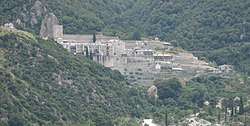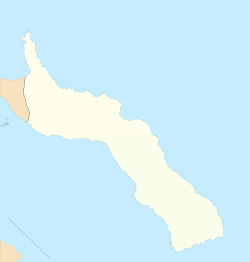Agiou Pavlou monastery
Agiou Pavlou monastery (Greek: Μονή Αγίου Παύλου; Romanian: Mănăstirea Sfântul Pavel) is an Eastern Orthodox monastery in the monastic state of Mount Athos, located on the easternmost peninsula of Chalkidiki, Greece. The founder of monastery was Paul of Xeropotamou, after whom it is named.

Αγίου Παύλου | |
 External view of the monastery | |
 Location within Mount Athos | |
| Monastery information | |
|---|---|
| Full name | Holy Monastery of Agiou Pavlou |
| Order | Greek Orthodox |
| Established | Before 1035[1] |
| Dedicated to | the Presentation of Jesus Christ at the Temple |
| Celebration date | 2 February |
| People | |
| Founder(s) | Saint Paul of Xeropotamou |
| Prior | Archimandrite Elder Parthenius (Mourelatos) |
| Site | |
| Location | Mount Athos |
| Coordinates | 40°09′40″N 24°17′25″E |
| Public access | Men only |
The monastery is in the western part of the Athos peninsula and its Katholikon (main church) is dedicated to the Presentation of Christ in the Temple. Its feast day is celebrated on 2 February. (Since the monastic community of Mount Athos observes the Julian Calendar, which is currently 13 days behind the civil calendar, 2 February on the Julian Calendar falls on 15 February of the modern Gregorian Calendar.)
History
The Monastery was founded in the late 10th to early 11th century by Saint Paul of Xeropotamou, also the founder of the Xeropotamou Monastery. Documents attest of its independence from Xeropotamou by 1035.[1] The Monastery was initially dedicated to Saint George but early on took the name of its founder. Its dedication was later changed to the Presentation of Jesus Christ to the Temple.
Between 1355 and 1365, the Serbian nobleman Antonije Bagaš, together with Nikola Radonja, bought and restored the ruined monastery, becoming its abbott.[2] The restoration of the monastery, supported by Radonja's brothers Vuk Branković and Grgur Branković, marked the beginning of the Serbian period of its history.[3][4] On October 14, 1410, Serbian Despot Đurađ Branković donated Kuzmin to the monastery, as it was the wish of deceased Prince Lazar Hrebeljanović.[5] Russian pilgrim Isaiah confirms that by the end of the 15th century the monastery was Serb.[6]
In October 1845 Porphyrius Uspensky took 12 leaves of the Radoslav Gospel during his visit, which according to his opinion were the most valuable, and gave them to the Russian National Library in St. Petersburg. The rest of the leaves which remained in the monastery were lost.
The monastery ranks fourteenth in the hierarchy of the Athonite monasteries. Its library contains 494 manuscripts, and over 12,000 printed books.[7]
The monastery contains 31 working monks and has two idiorrhythmic sketes (smaller, dependent monastic houses): the Romanian Lakkoskiti and the Greek Nea Skiti (New Skete).[7]
References
- S. Binon, Les origines légendaires et l'histoire de Xéropotamou et de Saint-Paul de l'Athos (Louvain, 1942)
- Angold, Michael (17 August 2006). "The Cambridge History of Christianity: Volume 5, Eastern Christianity". Cambridge University Press – via Google Books.
- Recueil de Vardar. Akademija. 2006. p. 5.
Герасим је обновио и манас- тир Светог Павла; тако је почео његов српски период.
- Miladin Stevanović; Vuk Branković (srpski velmoža.) (2004). Vuk Branković. Knjiga-komerc. p. 53.
...манастир Светог Павла, који су темељно обновили уз по- моћ браће Вука и Гргура Бранковића
- Zivkovic, Tibor. Charters of the Serbian rulers related to Kosovo and Metochia. pp. 123–124.
- A. E. Bakalopulos (1973). History of Macedonia, 1354-1833. [By] A.E. Vacalopoulos. p. 166.
At the end of the 15th century, the Russian pilgrim Isaiah relates that the monks support themselves with various kinds of work including the cultivation of their vineyards....He also tells us that nearly half the monasteries are Slav or Albanian. As Serbian he instances Docheiariou, Grigoriou, Ayiou Pavlou, a monastery near Ayiou Pavlou and dedicated to St. John the Theologian (he no doubt means the monastery of Ayiou Dionysiou), and Chilandariou. Panteleïmon is Russian, Simonopetra is Bulgarian, and Karakallou and Philotheou are Albanian.
- "Agios Pavlos page at Macedinian Heritage".
External links
| Wikimedia Commons has media related to Moni Agiou Pavlou (Athos). |